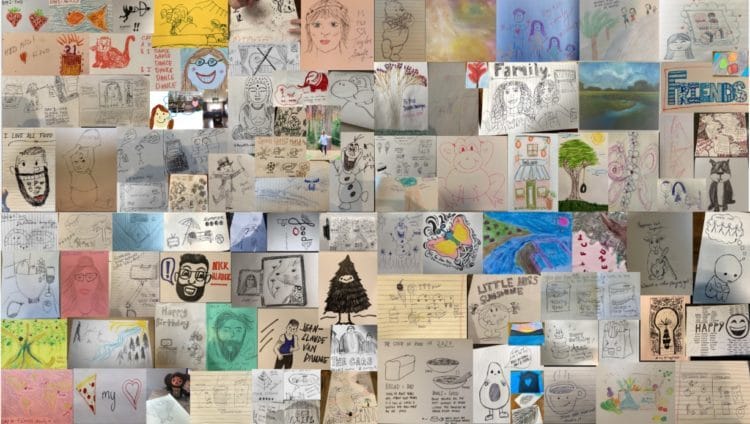The Game Changers
Creativity through crisis: Engaging employees during the COVID-19 pandemic
By Stefanie Coleman
Apr. 13, 2020
We’ve been anticipating a seismic shift in the world of work for years. With factors like digital disruption, climate change and divergent geo-politics, it is no surprise that the “future of work” has finally arrived.
But did we expect it to arrive on these terms? A pandemic is eviscerating our communities, emerging with little warning and threatening lives and the global economy. The sorrow is pervasive.
At first, we at PwC were workforce strategists living under a cloak of sadness. But we found relief through creativity.

I’ve been socially isolated in New York for almost a month. I’m finding that by dedicating some right brain thinking to my daily schedule, I’m working in new ways. Not only does my “creativity break” help me relax each day (particularly when it involves paint, glitter and crayons), it helps me re-energize and solve work problems from a new perspective.
Also read: Senior Living Facility Employees Benefit from Art Therapy
Daily, my daughter and I take a break and do an art project together. I have found that the quality of our art is getting better each day, and with that grows our confidence. This is showing in how I engage with my work when I’m inspired to try new things — like testing out a new automation tool in PwC’s Digital Lab or communicating with a client using a new technology.
I tested the impact of creative release with my team, which is why we made QUARANTINE DAYS, a collaborative art project involving a collection of drawings and doodles. In my career, I have worked with clients to solve the most complex workforce issues — but QUARANTINE DAYS is one of my most prized projects. It gives me joy to admire what we have built as a team, through times of fear, anxiety and sadness.
Also read: 7 Tips for Managers to Help Employees De-Stress
The Doodle Challenge: How we made it happen
Step 1: Know your audience. To make a project like this work, choose an audience that is willing to demonstrate vulnerability. For many, doodling is not a natural pastime. It helps if there is an established level of familiarity across the group.
Step 2: Establish collaboration tools. We created a virtual chat room called “doodle madness” that allowed us to share drawings in a no judgement zone and did not distract from formal business communications.
Step 3: Define roles. You need a leader who can sponsor the project and is willing to embarrass themselves sometimes and demonstrate vulnerability. The sponsor will share the first doodle of the day to encourage others (and in our case, set a very low precedent for artistic talent). You need a project manager to encourage participation and collate the artwork.
Step 4: Give encouragement. A deliberate effort to recognize individual contributions is important to long-term participation. We have promoted QUARANTINE DAYS on social and external channels to give our collaborating artists recognition for their part in this creative process. This has also served as a subtle motivator.
Also read: Consider Fresh Air and Relaxed Hikes to Combat Work Stress
What we’ve learned from the doodle challenge
When our project ended, we sought results on how the creative process made participants feel. Most loved the distraction and the intellectual liberties they experienced by letting the right brain take over. Some loved how their drawings made people laugh — providing comic relief in taxing times. Others thought it helped us connect as a team and get to know one another on a deeper level.
Hearing this, I am not surprised that Harvard Medical School found that casual doodling not only improves attention span but also relieves psychological stress. I think in the future, I might ask my teams to draw and present their ideas when we problem solve for clients — instead of scribbling down messy thoughts on a faded whiteboard.
I love this creative depiction of the process from my colleague, Anna Leiman.

Staying human, especially during a crisis, matters. It may seem obvious, but creativity is an outlet, and in times like COVID-19, we need it.
Not everyone likes to draw. Some like to cook, play instruments or dance in the living room. It doesn’t matter what outlet people prefer. The point is that we are human, and even if we can’t be together physically, by sharing in creativity and using these periods of social isolation for gratitude and reflection, we’ll get through COVID-19. And by engaging employees this way, we’ll come out of it stronger and more connected than ever before.
—–
Many thanks to the contributing artists from PwC’s Financial Services People & Organization team for their contributions to QUARANTINE DAYS: Bhushan Sethi, Julia Lamm, Jenna Jackson, Alex Spira-Gutner, Christy Wade, Mona Jolly, Taylor Goodman, Alexandra Hom, Lauren Hammond, Andrew Pallotta, Caroline Brainerd, Meg Connelly, Stefanie Goldberg, Stephanie Madarasz, Stephanie Sullan, Smital Patel, Nick Hladek, Jay Sharma, Anna Leiman, Rebecca Leopold, Nicolette Sortisio, Olivia Hewitt, Madeline Bryke, Zachary Horowitz, Dina Finkel, Charmaine Chan, Carolyn Tomlinson, Nicole Pollack, Armando De la Flor, Jamie Burke, Neil Patel, Alexandra Reyes and Victoria Sulenski.
Thank you also to members of the critical services workforce, including medical staff such as doctors, nurses and hospital administrators who work tirelessly to prevent the spread and destruction of COVID-19.
Schedule, engage, and pay your staff in one system with Workforce.com.